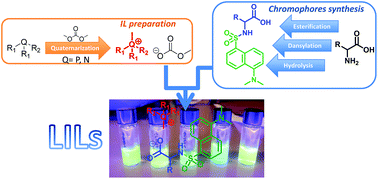Luminescent dansyl-based ionic liquids from amino acids and methylcarbonate onium salt precursors: synthesis and photobehaviour†
Abstract
Five new luminescent ionic liquids (LILs) derived from tryptophan (Trp), phenylalanine (Phe) and the dipeptide Gly-Gly functionalized with a dansyl chromophore moiety, were synthesized by an original protocol involving both green reagents/solvents such as non-toxic dimethyl carbonate (DMC: MeOCO2Me) and 2-propanol, and reaction conditions. In particular, DMC was used for: (i) the synthesis of methyltrioctyl methylcarbonate onium salts [Q1mmn][MeOCO2] (Q = N, m = 1, n = 8; Q = P, n = m = 4, 8) by P- and N-methylation of trioctylphosphine and trioctylamine, respectively, and (ii) acid-catalyzed esterifications of Trp and Phe to produce the corresponding methyl esters (Trp-OMe and Phe-OMe). Both reactions proceeded with >90% isolated yields and a mass index (esterifications) as low as 4.5. 2-propanol was used as the solvent for N-dansylation reactions where Trp-OMe and Gly-Glyethyl ester hydrochloride (Gly-Gly-OEt) were coupled to dansyl chloride (DNS-Cl) as a luminescent precursor. A final anion metathesis step between methylcarbonate onium salts and N-dansyl amino acid derivatives gave desired LILs of general formula [Q1mmn][DNS-X] (X = Trp, Phe, and Gly-Gly) in quantitative yields and with by-products minimization. Upon excitation (λex = 340 nm) in MeCN, all LILs exhibited green luminescence with emission quantum yields in the range of 33–41% and monoexponential emission lifetimes of 12.6 ± 0.5 ns. Moreover, each compound showed a remarkable hypsochromic shift in the peak emission wavelength when dissolved in solvents of decreasing polarity (from water to MeCN, toluene and CH2Cl2, respectively). A photostability test by a 350 nm continuous excitation on thin films of LILs proved that, after 10 min, the GlyGly derivative fully retained its PL intensity, while this (intensity) decreased from 10 to 25% for other LILs.


 Please wait while we load your content...
Please wait while we load your content...